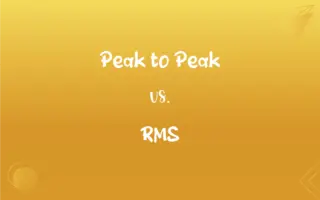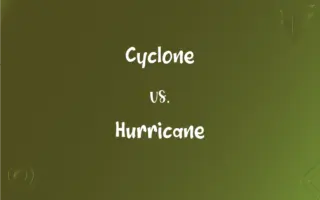Maps vs. Charts: What's the Difference?
Edited by Aimie Carlson || By Janet White || Published on December 20, 2023
Maps represent geographical areas, showing features like cities, roads, and landscapes. Charts are graphical representations of data, often used in statistics or finance.

Key Differences
Maps are tools for navigation and geographic understanding, often showcasing physical land features, political boundaries, and roads. Charts, in contrast, are used in various fields like finance, weather, and statistics to present data visually through bars, lines, or pie segments.
Charts serve to simplify and interpret complex data, making trends and patterns easier to understand; they are crucial in business, science, and education. Maps, meanwhile, offer a spatial understanding of the world, aiding in travel, urban planning, and exploration.
Maps vary from topographical to political, each with a specific focus like elevation or administrative boundaries. Charts, on the other hand, have types like bar, line, and pie charts, each tailored to present data in a unique and comprehensible manner.
In maps, accuracy and scale are paramount, as they directly affect navigation and geographical understanding. Charts prioritize clarity and data representation, ensuring that the presented information is easily digestible and accurate.
Maps often require updates to reflect changes in geography or political boundaries, underlining their dynamic nature. Charts, conversely, might be static or dynamic, reflecting historical data or real-time changes in areas like stock markets or weather.
ADVERTISEMENT
Comparison Chart
Purpose
Depict geographical areas and features
Display data or information graphically
Types
Topographic, political, thematic
Bar, pie, line, Gantt
Usage in Language
Often used in the context of travel and geography
Used in discussions involving data and statistics
Data Representation
Represents physical or political features
Represents numerical or categorical data
Visual Elements
Scale, symbols, legends
Axes, labels, keys
ADVERTISEMENT
Maps and Charts Definitions
Maps
A diagrammatic representation of an area of land or sea.
The treasure map led them to an uncharted island.
Charts
A diagram or series of diagrams showing the stages of a process.
The assembly chart made building the furniture much simpler.
Maps
A visual representation of an area showing physical features.
The hiker used a map to navigate the mountain trails.
Charts
A sheet exhibiting information in tabular or diagrammatic form.
The nutrition chart displayed the calorie content of various foods.
Maps
A symbolic depiction highlighting relationships between elements of space.
The city's bus map made commuting much easier.
Charts
A visual display of information or data.
The climate chart highlighted temperature changes over the decades.
Maps
A graphical representation of a geographic area for navigation.
The pilot referred to the flight map for the route.
Charts
A graphical representation of data to show patterns.
The sales chart showed an upward trend for the last quarter.
Maps
A drawing or other representation of the Earth's surface.
The classroom map displayed different countries and their capitals.
Charts
A detailed map used for navigation, especially at sea.
The captain studied the nautical chart to avoid shallow waters.
Maps
A representation, usually on a plane surface, of a region of the earth, intended primarily to provide information about the relative location or nature of features within that region.
Charts
A map showing coastlines, water depths, or other information of use to navigators.
Maps
A similar representation of a region of the sky or of a celestial object
A map of the constellations of the southern hemisphere.
Charts
An outline map on which specific information, such as scientific data, can be plotted.
FAQs
What is a map?
A map is a visual representation of an area, highlighting geographical features.
Can maps show elevation?
Yes, topographic maps specifically show elevation and terrain.
What are charts used for?
Charts are used to graphically display data or information.
Do maps always represent real places?
Most maps represent real places, but some can be fictional or thematic.
Is Google Maps a type of map?
Yes, it's a digital map for navigation and location-based information.
What is a legend on a map?
A legend explains the symbols and colors used on a map.
Do charts always have numbers?
Most charts use numbers, but some can represent categories or stages.
Are charts only for financial data?
No, charts can represent any data, including statistical, scientific, and educational.
Can maps be artistic?
Yes, maps can be artistic, especially historical or thematic ones.
How important is scale in maps?
Scale is crucial in maps for accurate distance representation.
What's a pie chart?
A pie chart is a circular graph divided into slices to illustrate numerical proportions.
How are maps updated?
Maps are updated using new geographical or political information.
Can charts be animated?
Yes, especially in digital formats to show changes over time.
What does 'map out' mean?
It means to plan or detail a strategy or idea clearly.
Are digital maps more accurate than paper maps?
Digital maps can be more current, but accuracy depends on the data source.
Are charts used in education?
Yes, charts are widely used in educational settings to illustrate concepts.
What's a thematic map?
A thematic map focuses on a specific theme or subject, like climate or population.
Can charts be misleading?
Yes, if not accurately constructed, charts can misrepresent data.
Are flow charts a type of chart?
Yes, flow charts depict a process or sequence of events.
What's the difference between bar and line charts?
Bar charts use bars to show data, while line charts connect data points with lines.
About Author
Written by
Janet WhiteJanet White has been an esteemed writer and blogger for Difference Wiki. Holding a Master's degree in Science and Medical Journalism from the prestigious Boston University, she has consistently demonstrated her expertise and passion for her field. When she's not immersed in her work, Janet relishes her time exercising, delving into a good book, and cherishing moments with friends and family.
Edited by
Aimie CarlsonAimie Carlson, holding a master's degree in English literature, is a fervent English language enthusiast. She lends her writing talents to Difference Wiki, a prominent website that specializes in comparisons, offering readers insightful analyses that both captivate and inform.








































































